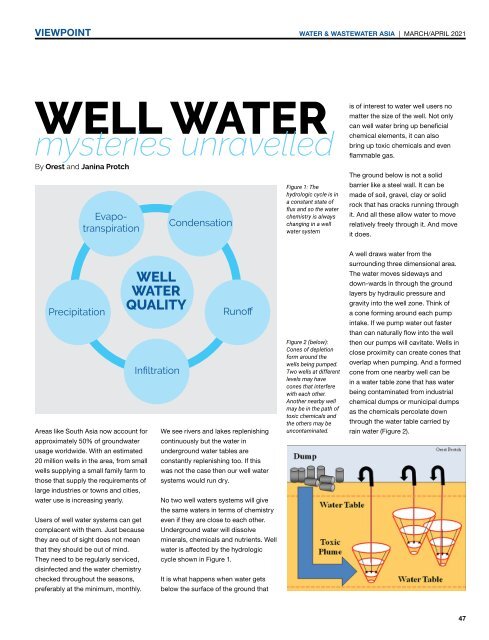Water & Wastewater Asia March/April 2021
Water & Wastewater Asia is an expert source of industry information, cementing its position as an indispensable tool for trade professionals in the water and wastewater industry. As the most reliable publication in the region, industry experts turn this premium journal for credible journalism and exclusive insight provided by fellow industry professionals. Water & Wastewater Asia incorporates the official newsletter of the Singapore Water Association (SWA).
Water & Wastewater Asia is an expert source of industry information, cementing its position as an indispensable tool for trade professionals in the water and wastewater industry. As the most reliable publication in the region, industry experts turn this premium journal for credible journalism and exclusive insight provided by fellow industry professionals. Water & Wastewater Asia incorporates the official newsletter of the Singapore Water Association (SWA).
You also want an ePaper? Increase the reach of your titles
YUMPU automatically turns print PDFs into web optimized ePapers that Google loves.
VIEWPOINT WATER & WASTEWATER ASIA | MARCH/APRIL <strong>2021</strong><br />
WELL WATER<br />
mysteries unravelled<br />
By Orest and Janina Protch<br />
is of interest to water well users no<br />
matter the size of the well. Not only<br />
can well water bring up beneficial<br />
chemical elements, it can also<br />
bring up toxic chemicals and even<br />
flammable gas.<br />
The ground below is not a solid<br />
Evapotranspiration<br />
Condensation<br />
Figure 1: The<br />
hydrologic cycle is in<br />
a constant state of<br />
flux and so the water<br />
chemistry is always<br />
changing in a well<br />
water system<br />
barrier like a steel wall. It can be<br />
made of soil, gravel, clay or solid<br />
rock that has cracks running through<br />
it. And all these allow water to move<br />
relatively freely through it. And move<br />
it does.<br />
Precipitation<br />
Areas like South <strong>Asia</strong> now account for<br />
approximately 50% of groundwater<br />
usage worldwide. With an estimated<br />
20 million wells in the area, from small<br />
wells supplying a small family farm to<br />
those that supply the requirements of<br />
large industries or towns and cities,<br />
water use is increasing yearly.<br />
Users of well water systems can get<br />
complacent with them. Just because<br />
they are out of sight does not mean<br />
that they should be out of mind.<br />
They need to be regularly serviced,<br />
disinfected and the water chemistry<br />
checked throughout the seasons,<br />
preferably at the minimum, monthly.<br />
WELL<br />
WATER<br />
QUALITY<br />
Infiltration<br />
We see rivers and lakes replenishing<br />
continuously but the water in<br />
underground water tables are<br />
constantly replenishing too. If this<br />
was not the case then our well water<br />
systems would run dry.<br />
No two well waters systems will give<br />
the same waters in terms of chemistry<br />
even if they are close to each other.<br />
Underground water will dissolve<br />
minerals, chemicals and nutrients. Well<br />
water is affected by the hydrologic<br />
cycle shown in Figure 1.<br />
Runoff<br />
It is what happens when water gets<br />
below the surface of the ground that<br />
Figure 2 (below):<br />
Cones of depletion<br />
form around the<br />
wells being pumped.<br />
Two wells at different<br />
levels may have<br />
cones that interfere<br />
with each other.<br />
Another nearby well<br />
may be in the path of<br />
toxic chemicals and<br />
the others may be<br />
uncontaminated.<br />
A well draws water from the<br />
surrounding three dimensional area.<br />
The water moves sideways and<br />
down-wards in through the ground<br />
layers by hydraulic pressure and<br />
gravity into the well zone. Think of<br />
a cone forming around each pump<br />
intake. If we pump water out faster<br />
than can naturally flow into the well<br />
then our pumps will cavitate. Wells in<br />
close proximity can create cones that<br />
overlap when pumping. And a formed<br />
cone from one nearby well can be<br />
in a water table zone that has water<br />
being contaminated from industrial<br />
chemical dumps or municipal dumps<br />
as the chemicals percolate down<br />
through the water table carried by<br />
rain water (Figure 2).<br />
47


















